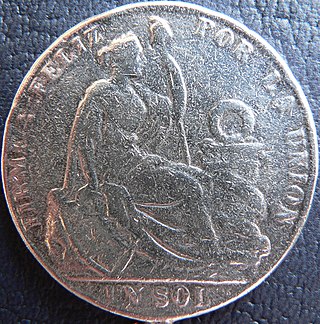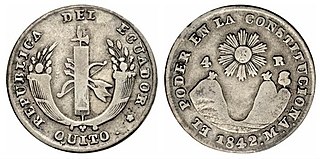This article needs additional citations for verification .(November 2023) |

The peso was the currency of Honduras between 1862 and 1931. [1]
This article needs additional citations for verification .(November 2023) |

The peso was the currency of Honduras between 1862 and 1931. [1]
The peso replaced the real at a rate of 1 peso = 8 reales. Initially, the peso was subdivided into 8 reales. In 1871, the currency was decimalized, with the peso subdivided into 100 centavos. The peso was replaced in 1931 by the lempira at par.
The first coin issues in 1862 were a provisional copper coinage in denominations of 1, 2, 4 and 8 pesos. This was followed between 1869 and 1871 by a cupro-nickel coinage in denominations of 1⁄8, 1⁄4, 1⁄2 and 1 real.
Silver 5, 10, 25 and 50 centavos and gold 1 peso coins were introduced that in 1871 following decimalization. Bronze 1 centavo coins were introduced in 1878, with bronze 2 centavos and silver 1 pesos added in 1881. Gold 5, 10 and 20 pesos coins were introduced between 1883 and 1889.
In 1886, the Aguan Navigation and Improvement Company issued its first paper money. The Banco Centro-Americano began note production in 1888, followed by the Honduran government in 1889, with several more banks issuing notes later. Denominations ranged between 50 centavos and 100 pesos.
Decimalisation or decimalization is the conversion of a system of currency or of weights and measures to units related by powers of 10.

The Philippine peso, also referred to by its Filipino name piso, is the official currency of the Philippines. It is subdivided into 100 sentimo, also called centavos.

The sol, later sol de oro, was the currency of Peru between 1863 and 1985. It had the ISO 4217 currency code PES. It was subdivided into 10 dineros or 100 centavos. It also had two different superunits over its circulation life, the inca (1881–1882) and later the gold pound, both worth 10 soles.

The Colombian peso is the currency of Colombia. Its ISO 4217 code is COP. The official peso symbol is $, with Col$. also being used to distinguish it from other peso- and dollar-denominated currencies.
The centavo is a fractional monetary unit that represents one hundredth of a basic monetary unit in many countries around the world. The term comes from Latin centum, with the added suffix -avo ('portion').

Philippine peso coins are issued by the Bangko Sentral ng Pilipinas for circulation in the Philippines and are currently available in seven denominations. The Philippine peso has been in use since Spanish rule.
The lempira is the currency of Honduras. It is subdivided into 100 centavos.

The Dominican peso, officially the peso dominicano since 2010, is the currency of the Dominican Republic. Its symbol is "$", with "RD$" used when distinction from other pesos is required; its ISO 4217 code is "DOP". Each peso is divided into 100 centavos ("cents"), for which the ¢ symbol is used. With exception of the United States dollar, it is the only currency that is legal tender in the Dominican Republic for all monetary transactions, whether public or private.
The peso was the currency of Paraguay between 1856 and 1944. It replaced the real at a rate of 8 reales = 1 peso. Until 1870, the peso was subdivided into 8 reales. Paraguay then decimalized, with 100 centésimos = 1 peso. The name of the subdivision was changed to centavo in 1874. The peso was replaced in 1944 by the guaraní at a rate of one hundred to one.

The peso was the currency of Costa Rica between 1850 and 1896. It was initially subdivided into 8 reales and circulated alongside the earlier currency, the real, until 1864, when Costa Rica decimalized and the peso was subdivided into 100 centavos. The peso was replaced by the colón at par in 1896
The peso was the currency of Guatemala between 1859 and 1925.

The venezolano was the currency of Venezuela between 1872 and 1879. It was divided into 100 centavos, although the names céntimo and centésimo were also used. Venezolano was also the name of two currencies planned in 1854 and 1865.

The peso was a currency of Venezuela until 1874. It was subdivided into 10 reales, each of 10 centavos.
The real was the currency of Argentina until 1881. From 1822, it was subdivided into 10 décimos. The sol was also issued during this period and was equal to the real, whilst the peso was worth 8 reales and the escudo was worth 16 reales.
The peso was the currency of El Salvador between 1877 and 1919.

The peso was a currency of Ecuador until 1884.

The real was the currency of Ecuador until 1871. There were no subdivisions but 16 silver reales equalled 1 gold escudo, with the 8 reales coin known as a peso.

The real was the currency of Peru until 1863. Sixteen silver reales equalled one gold escudo. The silver coin of 8 reales was also known as the peso.
The peso moneda nacional was the currency of Argentina from 5 November 1881 to 1 January 1970, the date in which the peso ley 18.188 was issued to the Argentine public. It was subdivided into 100 centavos, with the argentino worth 5 pesos. The peso was introduced to replace the Argentine peso moneda corriente at a rate of $+m⁄c 25 = m$n 1.
The Chilean peso was the legal tender of Chile from 1817 until 1960, when it was replaced by the escudo, a currency that was itself replaced in 1975 by a new peso.